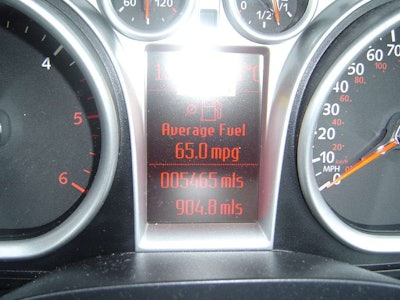
If you look in the center of the photo above, you’ll see a readout of 65 mpg. That’s the mileage a friend of ours, Peter Causer, of Volvo Construction Equipment, got in his Ford Focus 1.8 liter turbodiesel while in Europe two years ago. It’s a stick shift … but 65 miles per gallon!
“I ran it flat out for a week and this was the worst I could get out of it,” Causer says. “With a little less right foot, it would have been a lot better.” He also adds he rented an Audi A4 turbodiesel this Christmas and got more than 50 mpg with the bigger car.
The trouble in America is that everybody thinks the electric hybrid cars are the way to go. But a Prius gets an average of 46 mpg. The Chevy Volt is a bit messier since it runs solely on its battery the first 40 miles or so before the gas engine kicks in. The gas engine squeezes out at best 37 mpg.
And those are cars with giant batteries that could give out before the cars are halfway through their normal lifecycle. Early in 2012, Honda found itself in hot water over the battery life of its Civic Hybrid for that very reason, though Toyota’s Prius has fared better as Car and Driver found. These batteries cost $10,000 or so to replace. Surprise!
Diesel engines, by contrast, are proven technology and practically bulletproof. They last almost twice as long as gasoline engines, making their total lifecycle costs even lower.
Part of the problem is that people who are ignorant about everything that has to do with internal combustion engines (and this includes most of the people in government, the environmental movement and media) have this ill-informed notion that battery power is clean. It is not.
Battery-powered and hybrid vehicles get most of their propulsive energy from coal fired electrical plants. And as it turns out, burning coal to move your battery/hybrid car around the block is actually dirtier than using a purely gas or diesel-driven vehicle.
Auto industry analysts estimate that it costs $75,000 to build each Volt and yet GM is losing $49,000 for every one they build. No wonder government agencies are the only ones buying, and of course, for that, taxpayers pick up the tab. GM predicted annual sales of 40,000. In reality, they sold less than 11,000.
But official Washington loves a lie that makes them look good and the swells in the national media love to repeat the lie because it make them think that they’re on the side of the good guys.
But just because they all repeat it and believe it doesn’t make it true.
Fortunately, this government-sponsored, media-reinforced lie may be starting to lose it’s luster. On Jan. 22, The Wall Street Journal published an article “Dirty Old Diesel Gets Boost In Search for Fuel Economy.” The article is behind their paywall, so we can’t link to it here, but it noted that GM, Chrysler, and Mazda are going to offer diesel models in 2013. BMW, Audi and Volkswagen already offer a limited selection of oil burners here.
Ironically, the EPA’s CAFE standards may give diesel sales a boost in the United States. To meet the fleet average standard of 54.5 mpg by 2025, automakers will have to put more diesels into the mix.
Hybrids won’t cut it, and they never did. It’s just the laws of thermodynamics. Even the government can’t overturn those.











